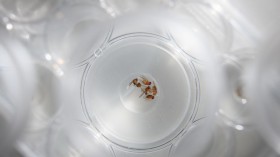Numerous calls to eradicate the invasive species have been made in response to the sight of multitudes of invasive carp being carried out to sea from Australian rivers. This strange method-releasing a herpes virus into their waterways-has been identified in their control plan.
Flooding Aftermath
As a result of severe flooding in the river basin for the past weeks during their breeding season, thousands of dead freshwater carp have been discovered washed up on ocean beaches in South Australia as of January 19, raising concerns about their invasive nature.
Middleton Beach, where locals claim they surfed in a school of carp, was one of the beaches that were particularly hard hit by the dead fish epidemic.
More than 3,000 homes in South Australia have been affected by recent severe flooding in the Murray-Darling river basin. This has coincided with carp breeding season, and it appears that the high river flows have washed the river fish downstream.
Invasive Carp in Australia
Invasive species include European carp in Australia. One genetic strain, the Boolara strain, caused a population explosion in the 1960s when it escaped from a fish farm in Victoria. As a result, millions of fish spread across the nation, mostly via the Murray-Darling river basin. These carp feed by foraging in riverbeds, which can harm aquatic vegetation and disturb water sediment, making it more difficult for native fish to survive.
And recent flooding is just one example of an event that has increased the population. According to ecologists from Charles Sturt University, the current abundance of carp is due to floods allowing them access to habitats in floodplains. There, each sizable female can produce millions of eggs, and the chances of the young surviving are high.
In the rivers and wetlands of Australia, it is estimated that there are more than 357 million of these carp. This estimate may be increasing as a result of the area's severe flooding, which has allowed the carp to spread to new areas. In some areas of the Murray-Darling basin, carp make up to 90% of all fish biomass, Newsweek reports.
Also Read: Ticks in Migrating Animals, Invasive Species, Increased Human-Wildlife Disease Transmission
Releasing the Herpes Virus into Waterways
To eradicate the invasive species, there have been new calls since the recent floods for releasing the Cyprinid herpesvirus 3, which will cause fatal disease in the carp.
According to a National Carp Control Plan published by the federal government in 2022, the carp herpes virus has the potential to reduce populations by 40% to 60% in more resilient populations, and by up to 80% in less resilient populations. According to a Conversation article, it also stated that additional research was required before releasing the virus due to several concerns, such as cleaning up dead carp and possible significant reductions in water quality and native fish.
Mel Gray, a water campaigner for the Nature Conservation Council, told ABC News Australia that she was disappointed by the delay and worried that the government was losing any interest in the control method.
Gray stated that if they don't have strong political intentions to protect local wildlife, the river will eventually become carp-only. She emphasized that research has been conducted, science has been completed, and that it is known that the virus will not jump from one species to another, Newsweek reports.
Related Article: Maryland Eradicates Invasive Rodent Species Nutria at the Cost of $30 Million, Fears of Reinvasion Still Linger
© 2024 NatureWorldNews.com All rights reserved. Do not reproduce without permission.





